Long-Term Care Billing Guidelines: An Ultimate Guide
In this blog, we will discuss what a long-term care facility is and how they bill their patients. We will also talk about the main steps that occur when the billing process starts, and common challenges faced.

Did you know in the United States there are 65,600 long-term care facilities?
This is because 70% of seniors end up in a long-term care facility.
So with that many people in need of a long-term care facility, understanding what long-term care is and how the billing process works is vital.
In this blog, we will discuss what a long-term care facility is and how they bill their patients. We will also talk about the main steps that occur when the billing process starts, and common challenges faced.
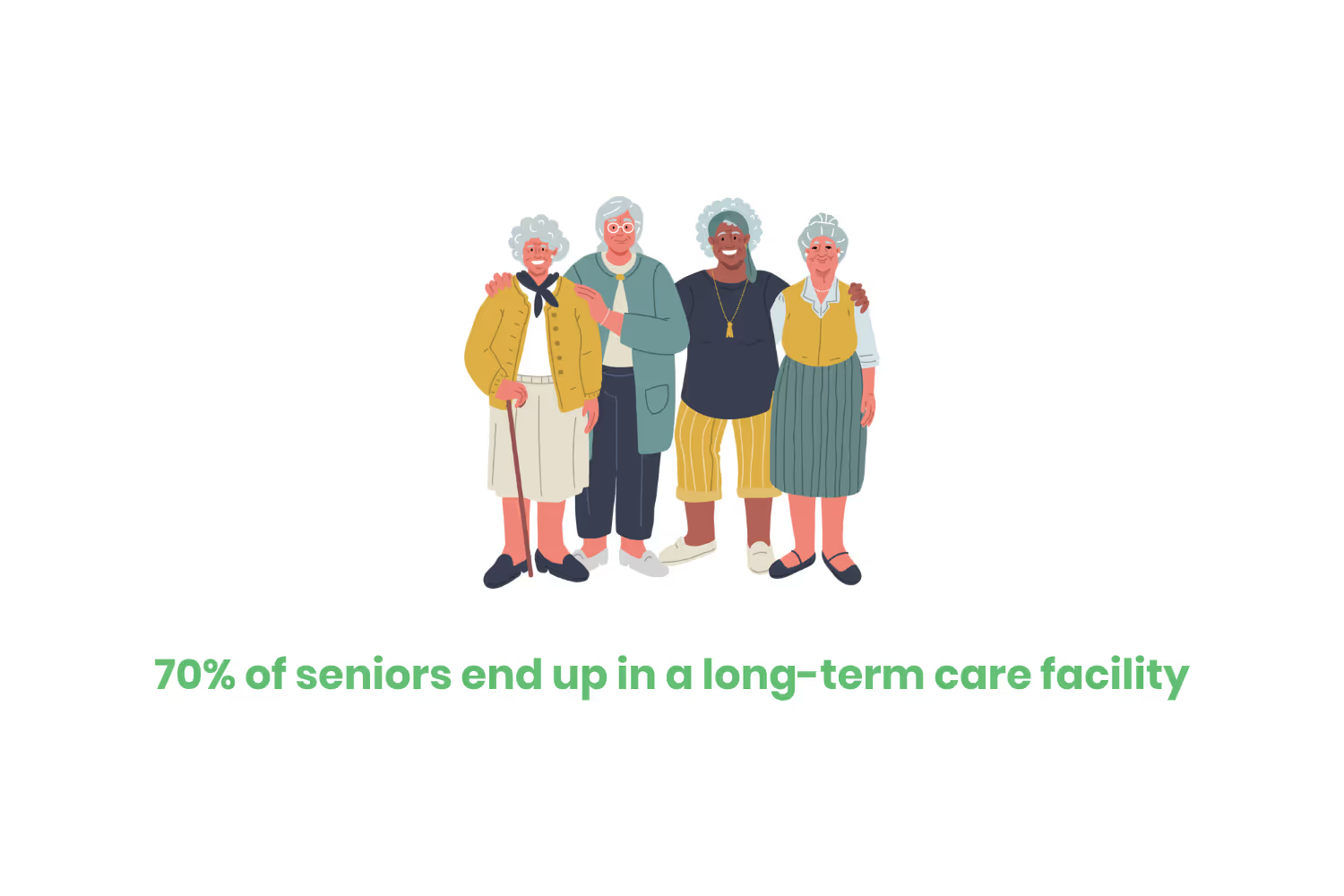
What is Long-Term Care?
Long-term care facilities assist both older and disabled patients. These facilities can tailor their assistance to the needs of the patient. This can help the patient remain as independent as possible but still get help in the areas they may need more assistance with.
There are a large number of different types of long-term care facilities but the most common facilities are nursing homes and assisted living homes.
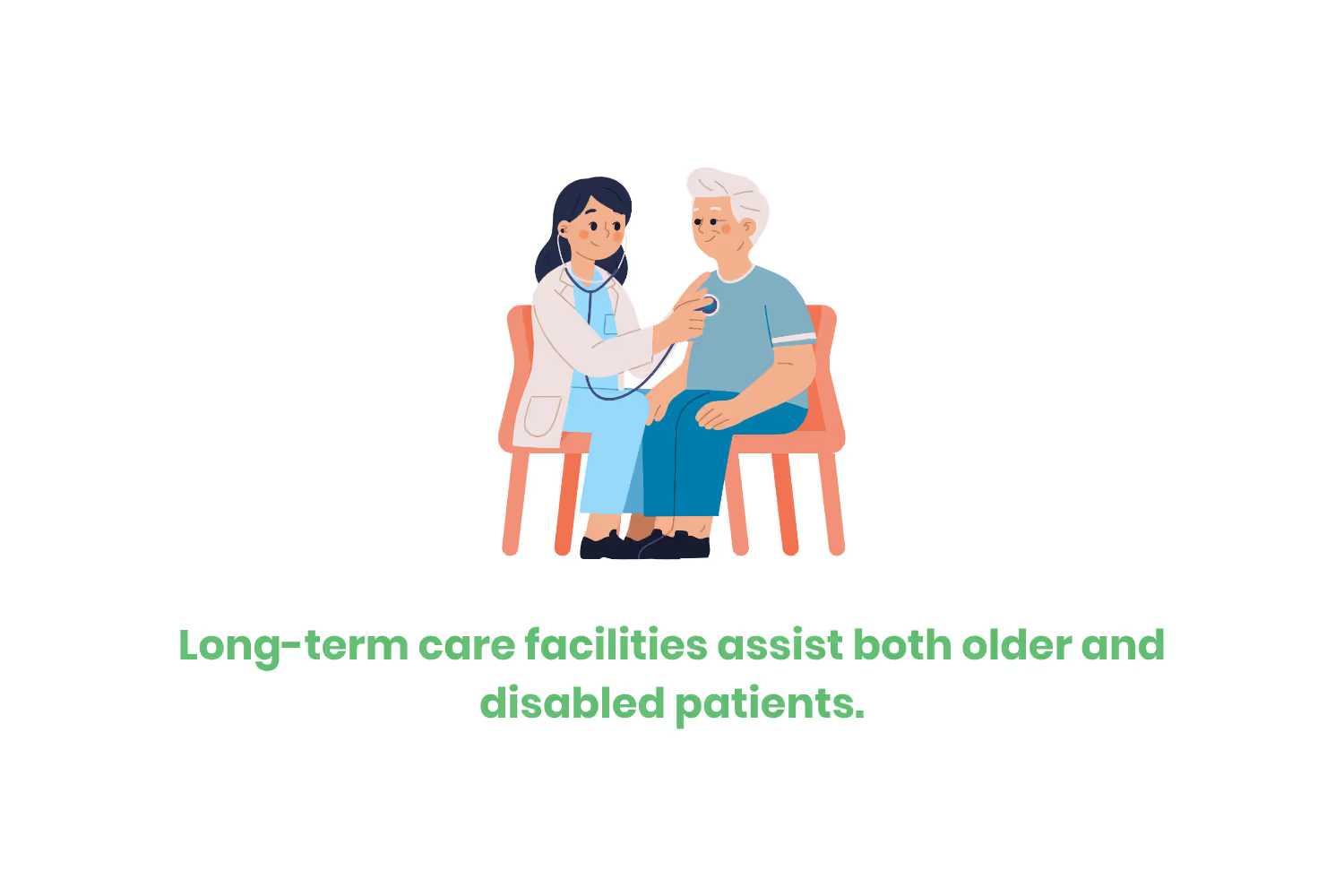
The most common examples of long-term care facilities are…
- Nursing Homes: a facility that helps the elderly, when they can no longer receive care at home. The facility can provide some medical care as well to ensure they stay comfortable. There is no maximum or minimum amount of time people stay in a nursing home. It is most common for patients to stay there until they pass.
- Assisted Living Homes: a facility for the elderly or disabled individuals, an Assisted Living Home is for patients who are more independent. Allowing the patients to keep their independence but also receive help where needed from a nurse. Patients tend to stay in an assisted living home for two to three years, depending on their health.
Each facility can help a different patient and their specific needs. Understanding the patient’s needs, and what your facility is capable of helping with is vital.
Steps to Long-Term Care Billing
Step 1: Patient Admissions
When the patient gets admitted to a facility, there is a very tedious admission process that takes place. The facility first requires their health history, which should include a list of all medicines and their insurance information. Depending on the patient's insurance will determine how much the patient will pay out of pocket.
They will also need to provide paperwork from their physician's office that states they require admission into the facility.
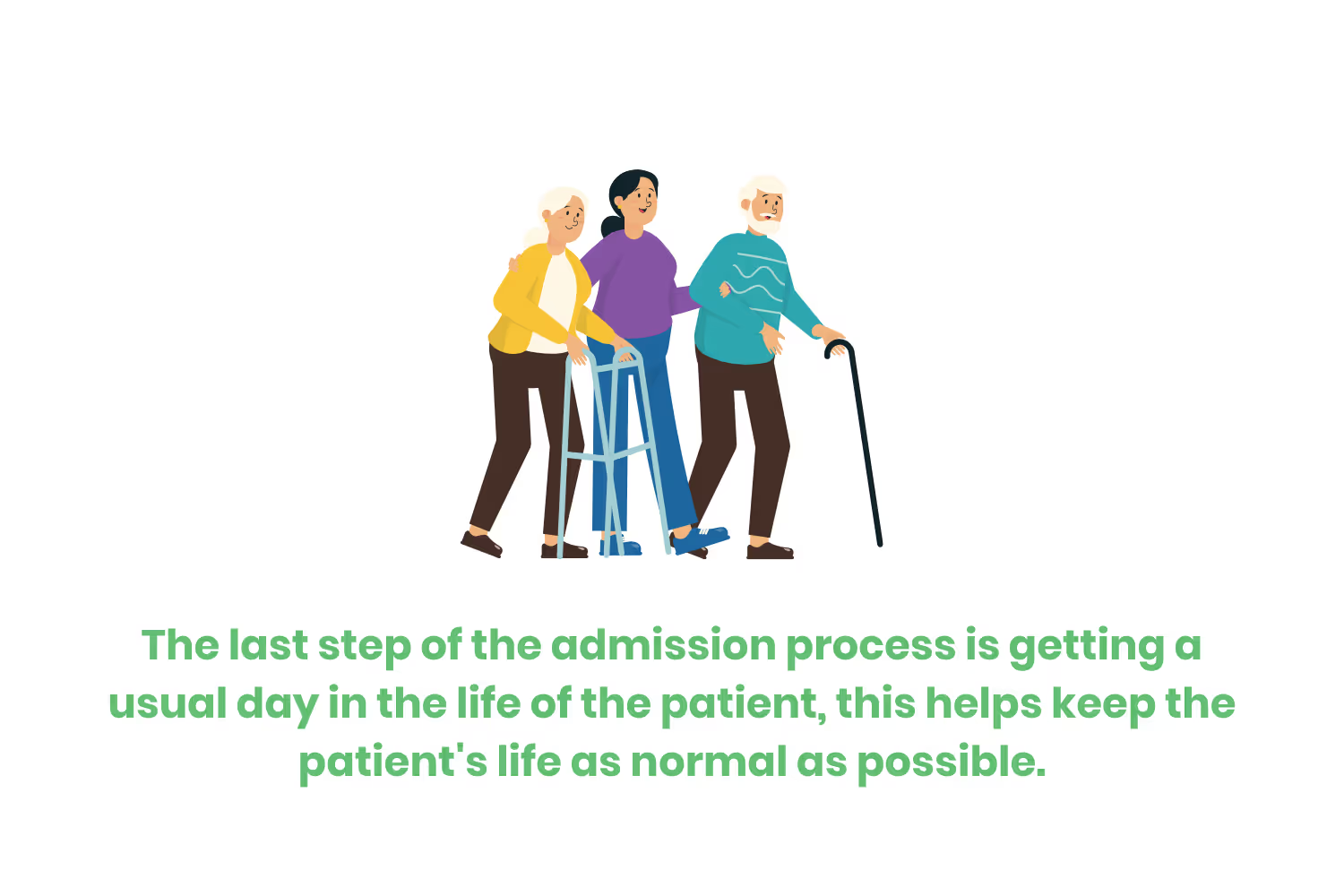
Along with that information, the facility will need the contact information of primary care or any other physicians, they will also need an emergency contact.
Then the patient will need to sign consent forms that allow the facility to help provide care.
The last step of the admission process is getting a usual day in the life of the patient, this helps keep the patient's life as normal as possible. The change in living arrangements can be a lot for patients so keeping their schedule the same can help them have an easier transition.
Step 2: Billing Department Assigns CPT Codes
Most long-term care facilities bill the patient once a month for the stay. The facility's billing department will look at the services provided to the patient via the physician's notes.
They will take what is being billed and assign a Current Procedural Terminology (CPT) code to it. This makes it easier for communication between the payer and the billing department.
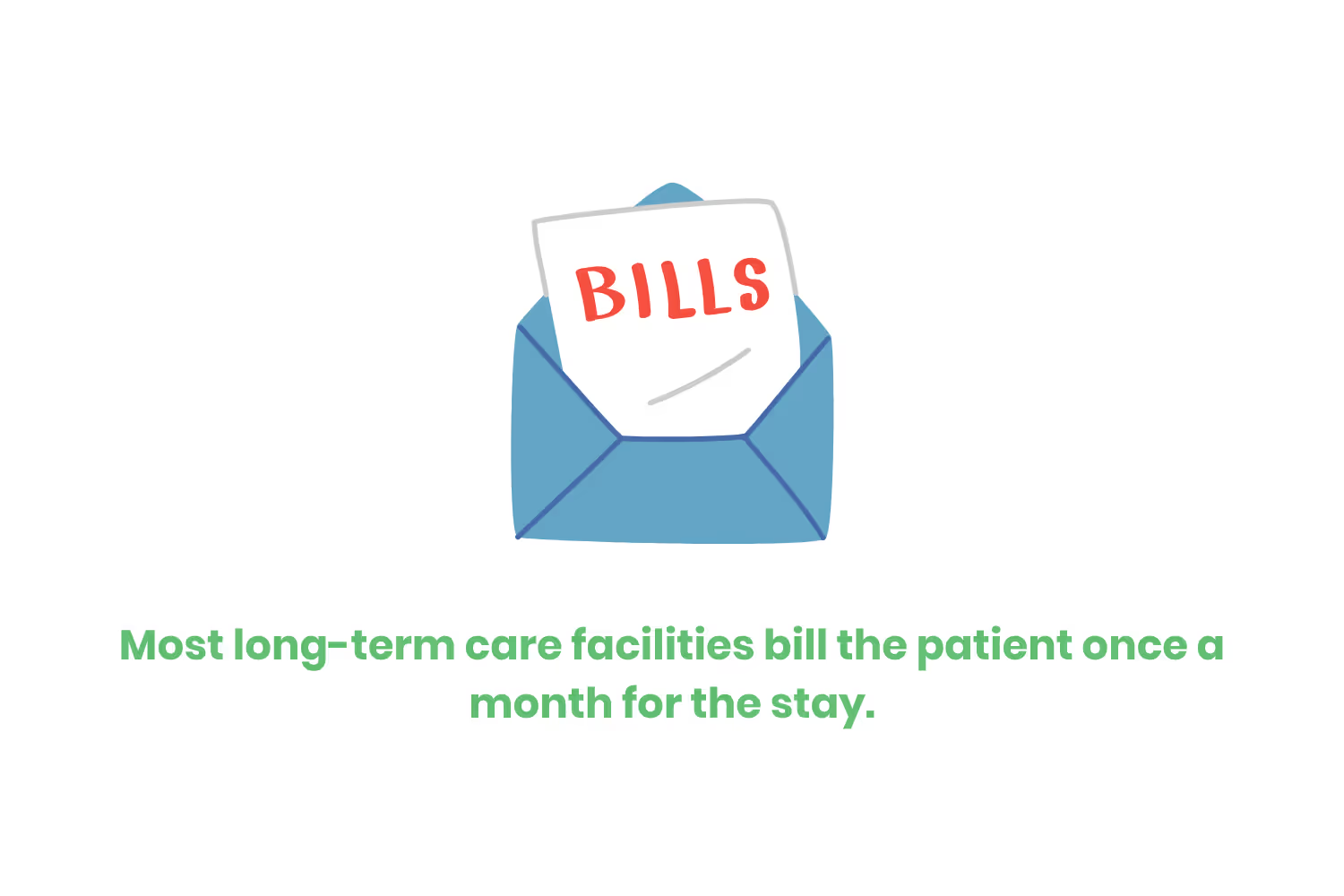
Step 3: Submitting The Claim to The Payer
After the billing department connects the billing notes to a CPT code, it will go to the payer.
The payer is typically the patient or the patient's power of attorney.
Some companies use something called a claims clearinghouse, which will scrub the claim to ensure there are no errors. This helps streamline the billing process and helps the facility get their payment sooner.
Since most insurance companies do not cover long-term care facilities, the patients or their power of attorney would be responsible. There are government programs that can assist the patient if they qualify, that can help with the payments.

Step 4: Denial Codes
If the patient’s insurance company does cover some of the treatment and a claim was sent regardless, there’s a chance of the billing department receiving a denial. Denials usually happen because there was some sort of error in the bill the insurance provider received.
Here are the most common denial codes in a long-term care billing department:
- CO 151 indicates that the insurance company does not think the procedure completed was medically necessary.
- CO 15 is the code provided when there was no authorization given before the procedure
- CO 27 is a common denial code, and it represents that the patient’s insurance coverage has expired
Denial codes can be very annoying but they’re also very avoidable. You can avoid them by training your staff to be more detail-oriented or by using a clearinghouse. Limiting denial codes can help ensure a faster payment process.
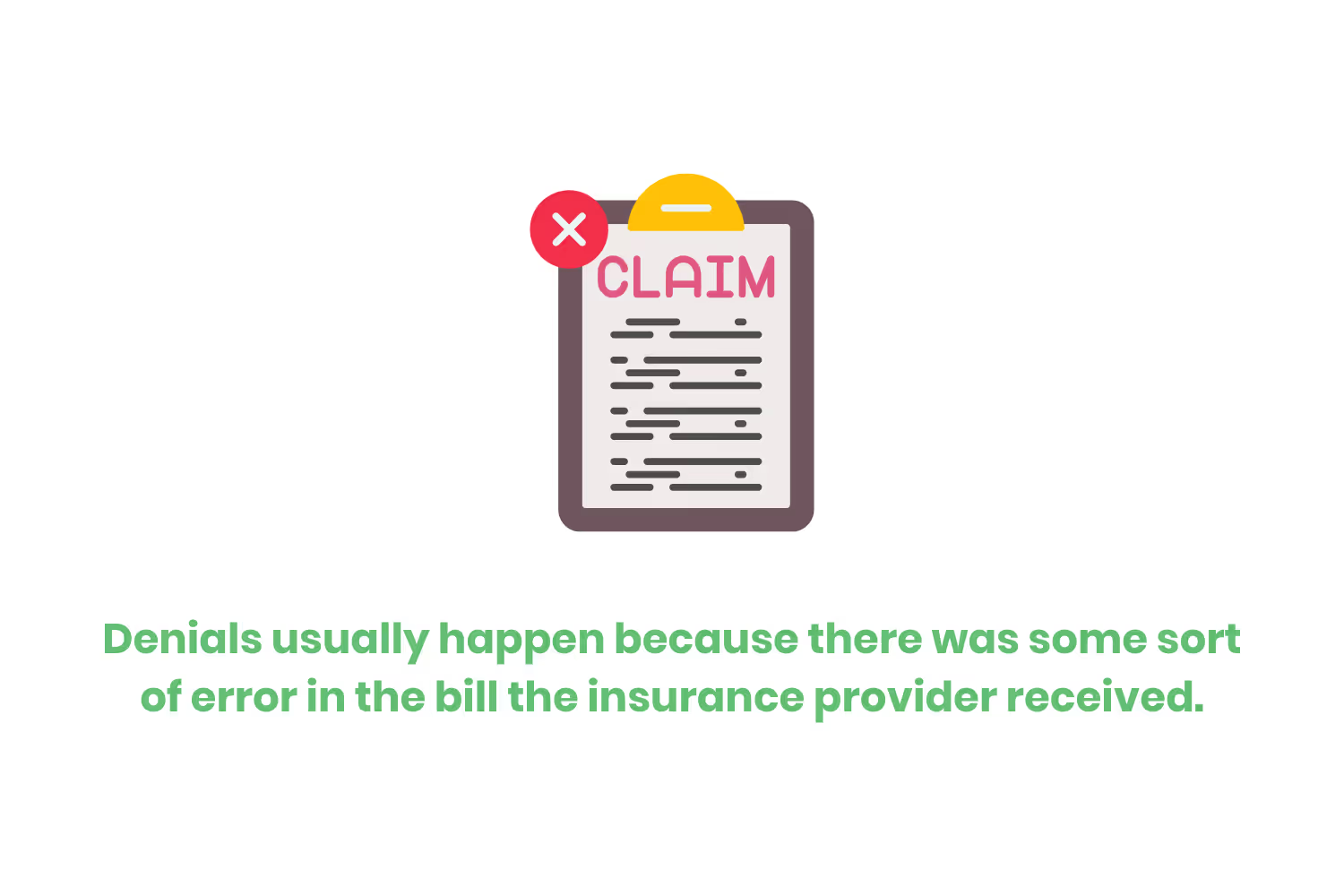
Step 5: Creating & Sending Statements to Patients
Once the billing department reviews the reimbursement amount that they will be receiving, they will start making the statement for any outstanding balance(s) owed.
The statement will show how much the insurance company covers and what’s left for the patient to pay. This statement gets sent to the patient via mail or email. Meanwhile, long-term care billing facilities await their payment.
Designing, printing and mailing statements manually is a huge bottleneck for many long-term care organizations. It’s an arduous process, you see. What gets harder is that long-term care facilities have to also keep in mind that family members are usually the individuals who assume financial responsibility on behalf of patients.
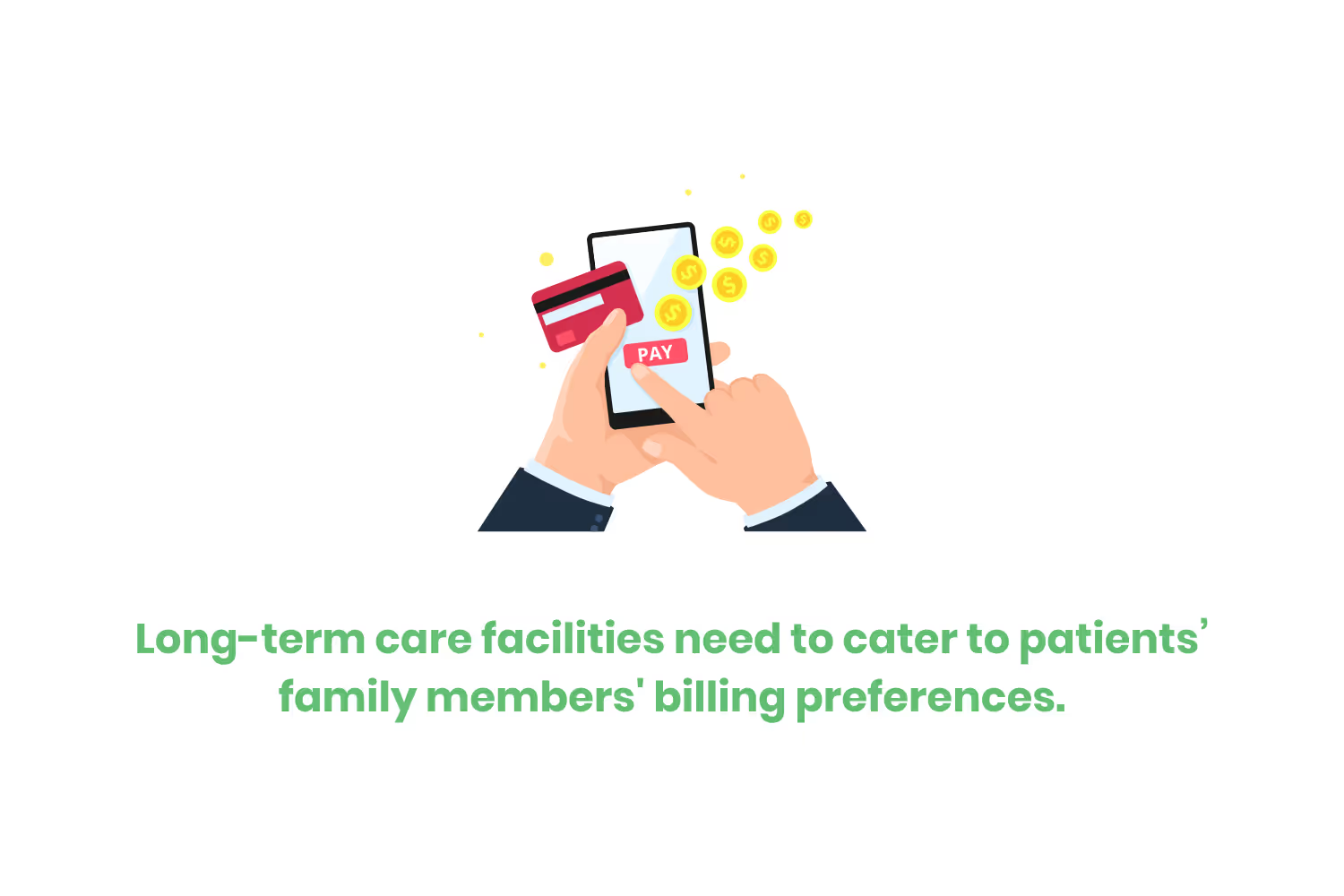
In most cases, healthcare organizations need to only understand their patients' billing preferences. However, in the long-term care space, they have to go one step further and cater to patients’ family members' billing preferences.
How do they do this? It’s a simple answer with a complex problem — offering multiple statement delivery methods such as email and SMS.
Doing this manually simply isn’t an option. Thus, they usually outsource their statement printing and mailing to a third party (like us) to not only be able to provide multiple different delivery methods but also automate this process entirely.
Step 6: Collecting Payemtn via Payment Gateway
In addition to multiple statement delivery methods, it’s also very important to be able to collect from multiple different payment methods.
In fact, accepting just three methods rather than only one can increase conversions by up to 30%.
Similar to the section before this, the answer to this problem comes from outsourcing. Remember that third-party organization that helps long-term care organizations with statement delivery? It should also be able to provide you with an automated way to accept multiple forms of payment.
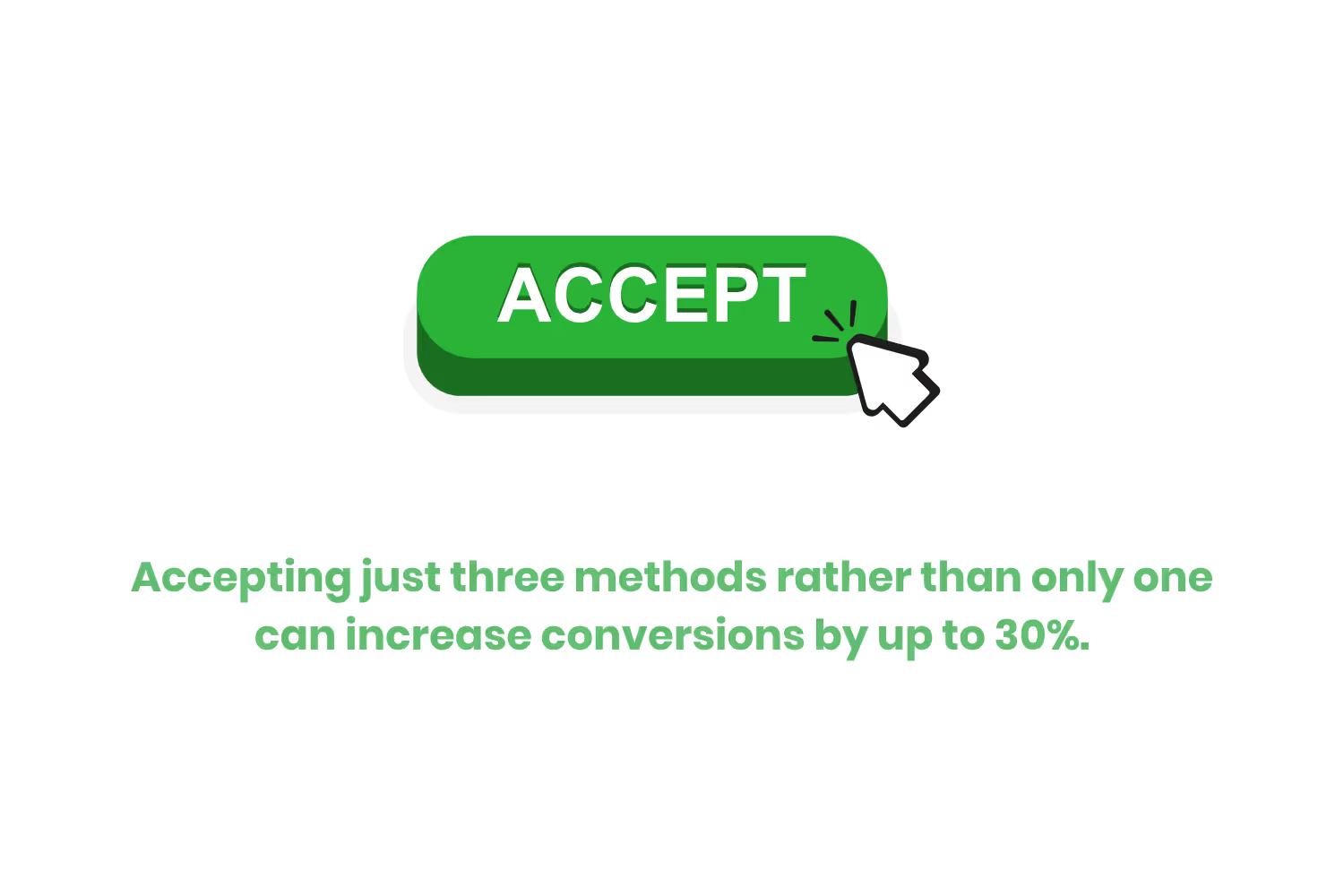
Of course, what I’m referring to is a payment gateway. This platform assists patients with…
- Making electronic payments
- Accepting multiple forms of payment
- Creating payment plans to make services more affordable
- Setting up autopay
Using a payment gateway helps further guarantee that the payment happens. The office can track when the patient received the bill, even sometimes when they open the bill!
Now all of this seems straightforward…right?
Rules and Regulations in Billings
When it comes to billing, it’s vital that your employees understand its nuances. However, training in the healthcare field extends far beyond billing.
For example, if a patient uses Medicare, there are regulations that need attention before the bill gets sent to the payer. Medicare does not cover long-term care for everyone, it is only patients that qualify for Medicare.
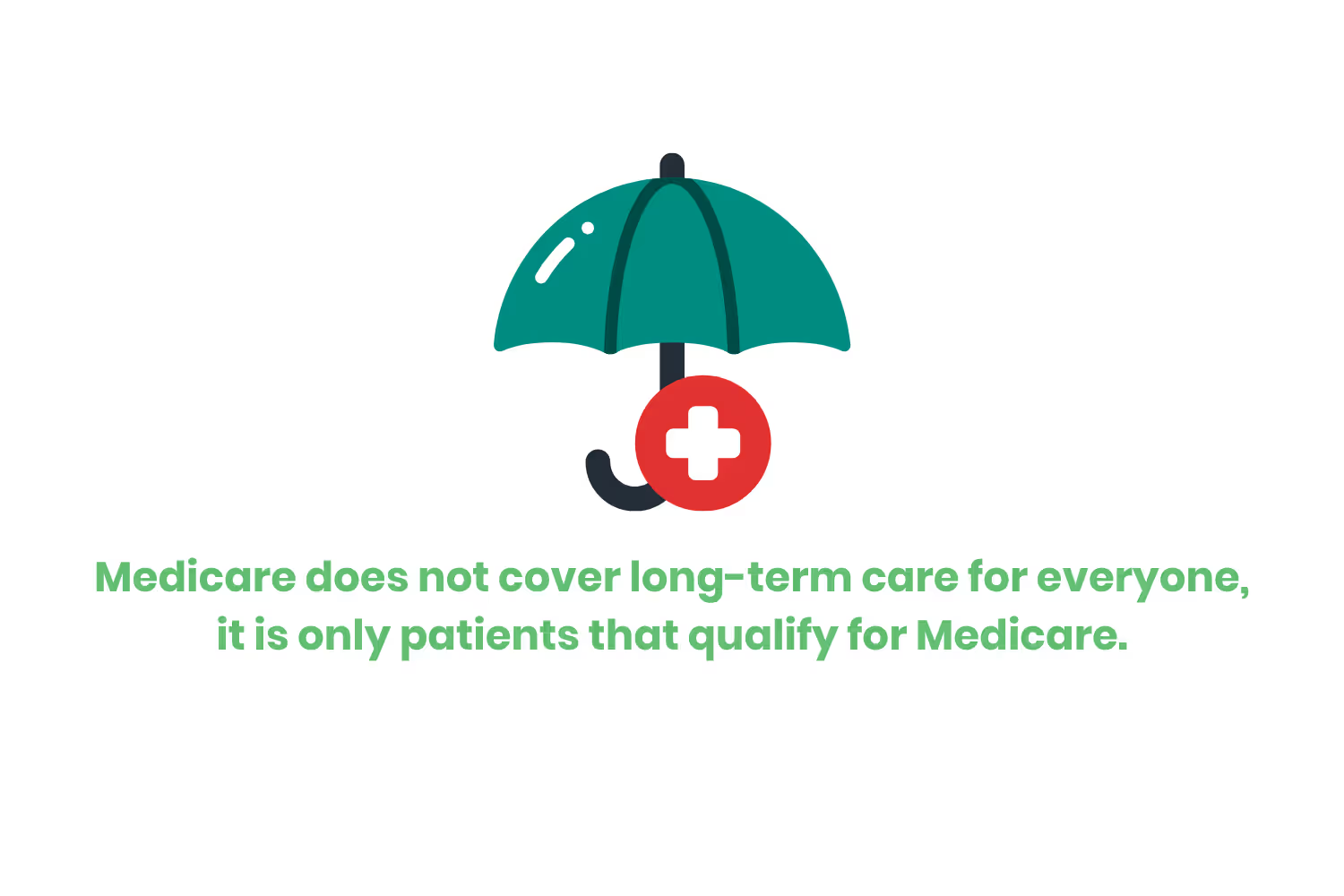
Ensuring that the patient meets those requirements and informing them if the situation changes can help keep an open line of communication during the billing process.
You see, it’s also vital that they understand how to follow HIPAA regulations. Having up-to-date training, with the ever-changing regulations will allow you to avoid being non-compliant.
Training can get complicated, but we can help, we have training materials here to help you stay HIPAA compliant.
Challenges in Long-Term Care Billing
There are a lot of challenges that can occur with the billing process for long-term care facilities.
The largest problem is attempting to keep track of all of the payers. Since there are many different channels that money can come from. There are also different rules and regulations that each channel requires.
With insurance providers, the billing office receives denial codes even if there is a slight error. If the patient has Medicare, it can be hard to keep track of what will get covered and how to send the bill.
The other challenge long-term care providers face is keeping everything documented correctly for the billing department. If everything is not documented correctly the insurance company may not provide payment.
Conclusion
Long Term Care facilities' billing processes can seem pretty straightforward. Understanding what your care facility offers and the correct steps to billing can help streamline your billing process. Ensuring you keep up with all regulations, and employee training can make sure you get your money on time.
Another important thing to keep in mind is communicating with your patients to make sure you do not have any miscommunications about what is coverable.
Emphasize your product's unique features or benefits to differentiate it from competitors
In nec dictum adipiscing pharetra enim etiam scelerisque dolor purus ipsum egestas cursus vulputate arcu egestas ut eu sed mollis consectetur mattis pharetra curabitur et maecenas in mattis fames consectetur ipsum quis risus mauris aliquam ornare nisl purus at ipsum nulla accumsan consectetur vestibulum suspendisse aliquam condimentum scelerisque lacinia pellentesque vestibulum condimentum turpis ligula pharetra dictum sapien facilisis sapien at sagittis et cursus congue.
- Pharetra curabitur et maecenas in mattis fames consectetur ipsum quis risus.
- Justo urna nisi auctor consequat consectetur dolor lectus blandit.
- Eget egestas volutpat lacinia vestibulum vitae mattis hendrerit.
- Ornare elit odio tellus orci bibendum dictum id sem congue enim amet diam.
Incorporate statistics or specific numbers to highlight the effectiveness or popularity of your offering
Convallis pellentesque ullamcorper sapien sed tristique fermentum proin amet quam tincidunt feugiat vitae neque quisque odio ut pellentesque ac mauris eget lectus. Pretium arcu turpis lacus sapien sit at eu sapien duis magna nunc nibh nam non ut nibh ultrices ultrices elementum egestas enim nisl sed cursus pellentesque sit dignissim enim euismod sit et convallis sed pelis viverra quam at nisl sit pharetra enim nisl nec vestibulum posuere in volutpat sed blandit neque risus.

Use time-sensitive language to encourage immediate action, such as "Limited Time Offer
Feugiat vitae neque quisque odio ut pellentesque ac mauris eget lectus. Pretium arcu turpis lacus sapien sit at eu sapien duis magna nunc nibh nam non ut nibh ultrices ultrices elementum egestas enim nisl sed cursus pellentesque sit dignissim enim euismod sit et convallis sed pelis viverra quam at nisl sit pharetra enim nisl nec vestibulum posuere in volutpat sed blandit neque risus.
- Pharetra curabitur et maecenas in mattis fames consectetur ipsum quis risus.
- Justo urna nisi auctor consequat consectetur dolor lectus blandit.
- Eget egestas volutpat lacinia vestibulum vitae mattis hendrerit.
- Ornare elit odio tellus orci bibendum dictum id sem congue enim amet diam.
Address customer pain points directly by showing how your product solves their problems
Feugiat vitae neque quisque odio ut pellentesque ac mauris eget lectus. Pretium arcu turpis lacus sapien sit at eu sapien duis magna nunc nibh nam non ut nibh ultrices ultrices elementum egestas enim nisl sed cursus pellentesque sit dignissim enim euismod sit et convallis sed pelis viverra quam at nisl sit pharetra enim nisl nec vestibulum posuere in volutpat sed blandit neque risus.
Vel etiam vel amet aenean eget in habitasse nunc duis tellus sem turpis risus aliquam ac volutpat tellus eu faucibus ullamcorper.
Tailor titles to your ideal customer segment using phrases like "Designed for Busy Professionals
Sed pretium id nibh id sit felis vitae volutpat volutpat adipiscing at sodales neque lectus mi phasellus commodo at elit suspendisse ornare faucibus lectus purus viverra in nec aliquet commodo et sed sed nisi tempor mi pellentesque arcu viverra pretium duis enim vulputate dignissim etiam ultrices vitae neque urna proin nibh diam turpis augue lacus.



![[ANSWERED] What is a Long-Term Care (LTC) Pharmacy](https://cdn.prod.website-files.com/67e2b8210878abcba6f91ae6/68d687806a075a1cf64659b0_WhatisLongTermCarePharmacy_925.avif)
